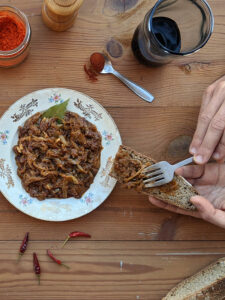Badass to eat perfect fruits, with good amount of pulp and almost no seeds or pits, nowadays it seems strange to talk about fruits that do not share these characteristics, But, instead, they are a burst of authentic taste far removed from the corky taste of mass marketed fruit. Specifically, we are talking about some autumn fruits that have been losing their presence on our table in recent decades. Usual in the food of our grandparents at this time of the year, today it is almost impossible to find them, because of the commercial circuits that have discarded them in favor of fruits that are more beautiful than good.
The sorolla (fruit of Azarolus hawthorn), also called azerola, it is a round edible fruit of red or yellow color, fleshy and sweet and sour taste. His cultivation, which was already done in Roman times, was very present in Valencian lands.
The edge (fruit of Sorbus domestica), despite having a form similar to noise, it is more of a greenish or earthy color, but it is only pleasant to the palate when overripe, in the same way as with the nespla (fruit of Mespilus Germanica), which is also eaten once the pulp begins to soften. Cal don't confondre the nespla (see here some photos) with the Japanese loquat fruit (Eriobotrya japonica) which is harvested in the spring and is very present in our country, even with appellation of origin in Callosa d'en Sarrià.
l

L’tree or Arboç cherry is a spherical fruit (of theArbutus unedo), two or three centimeters in diameter, red on the outside and yellow on the inside, granular surface and with three or four small and compressed seeds. Popular tradition says that if you eat a few you can end up drunk, since the arboç contains a certain proportion of ethanol.
He lledoner (Southern Celts) is a very common tree in the Mediterranean, it is even present in the Cap i Casal gardens. The fruit of this tree, called ledo, he was so well known that he even has a Marian invocation in the capital of La Plana, the Mother of God of Lledó. With the wood of this tree, formerly, the xicalla manufactured shooters to play and, the older ones, they made flutes out of it, gaiatos, forks and other utensils (read this interesting article from Method Magazine . its fruit, he led, it is a rounded drupe that is black on the outside and yellow on the inside.
Of the latter, probably the best known and one of those that can be found in the markets lately, is the necklace (fruit of Ziziphus jujube), a species of ovoid drupe, with dark skin with yellowish flaps and yellowish flesh. It is usually a tree present in orchards and dry-land cottages and that is why its commercialization has been late because it was not considered a first quality fruit.
Although most are difficult to achieve, to the Lita stop of the Russafa market you will find necklaces, sorolles i serves.
On the other hand, for sure you will know quinces and pomegranates, even if there is no excessive consumption of these fresh fruits, especially the first one. Traditionally the codony (fruit of Quince oblong) it was highly valued for its aroma (there were those who put it next to their clothes to perfume them) i, although traditionally in Valencia it is toasted in the oven (like we do with apples or pumpkins), the star product made from quince is quince. We have Valencian companies that make them: Master Confectioner i Paiarrop of Alcúdia (Upper Ribera) i Sweets La Cartuja of Height (High Palancia). The latter produces with and without sugar. We propose a different recipe typical of the Maestrat, which is a quince liqueur. See the recipe here! Learn more recipes with quince? Send them to us at [email protected].
The pomegranate (fruit of Pink garnet) is a fairly well-known fruit, although many people may be too lazy to peel them. With vinegar, orange juice or mistela are usually mixed with the grains to have a refreshing and tasty dessert. In the south of Valencia we are fortunate to have a production of high quality pomegranates that are distributed everywhere. Apart from that, many products such as juices are made from it, vinegar cream or, even, honey from the flowers of the pomegranate tree. In it Vitalgrana company website you will find more references. Sweets La Cartuja, also prepares a pomegranate jam.
arrived here, we will name other autumn fruits such as persimmons (fruit of Diospyros kaki), with denomination of origin Ribera del Xúquer; THE blackberries (fruits of the Rubus ulmifolios), the harvest of which is often brought forward in the summer due to climate change), and the shovel figs (fruit of theOpuntia fig-indica). We will talk about these and other autumn fruits in future articles.
XAVIER BENAVENT / MARTINA MONLLAU














